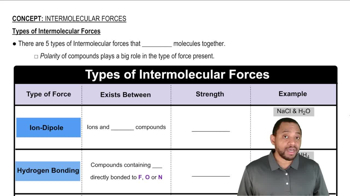List the three states of matter in order of (b) increasing intermolecular attraction.
As a metal such as lead melts, what happens to (a) the average kinetic energy of the atoms? (b) the average distance between the atoms?
 Verified step by step guidance
Verified step by step guidanceKey Concepts
Kinetic Energy and Temperature

Phase Changes

Interatomic Forces

(a) How does the average kinetic energy of molecules com- pare with the average energy of attraction between mole- cules in solids, liquids, and gases?
(c) What happens to a gas if you put it under extremely high pressure?
At room temperature, Si is a solid, CCl4 is a liquid, and Ar is a gas. List these substances in order of (a) increasing intermolecular energy of attraction
At standard temperature and pressure, the molar volumes of Cl2 and NH3 gases are 22.06 and 22.40 L, respectively (b) On cooling to 160 K, both substances form crystalline solids. Do you expect the molar volumes to decrease or increase on cooling the gases to 160 K?
At standard temperature and pressure, the molar volumes of Cl2 and NH3 gases are 22.06 and 22.40 L, respectively. (c) The densities of crystalline Cl2 and NH3 at 160 K are 2.02 and 0.84 g/cm3, respectively. Calculate their molar volumes.
